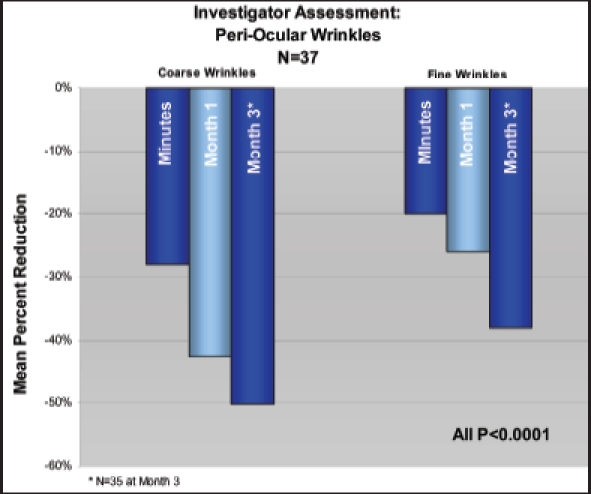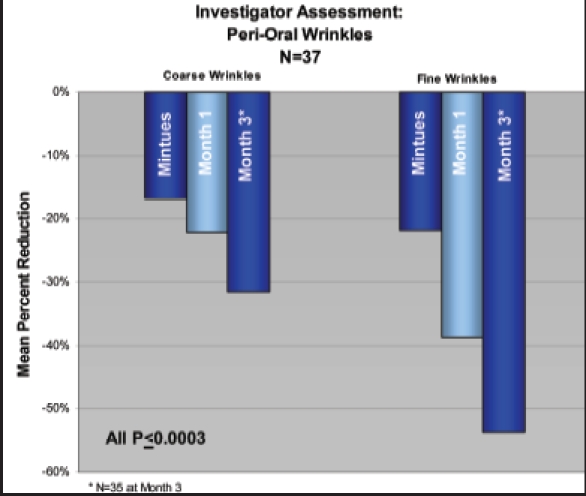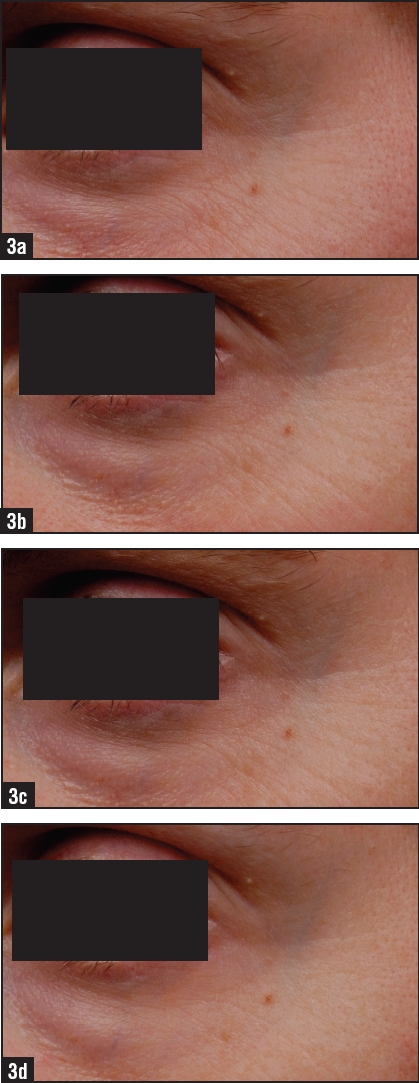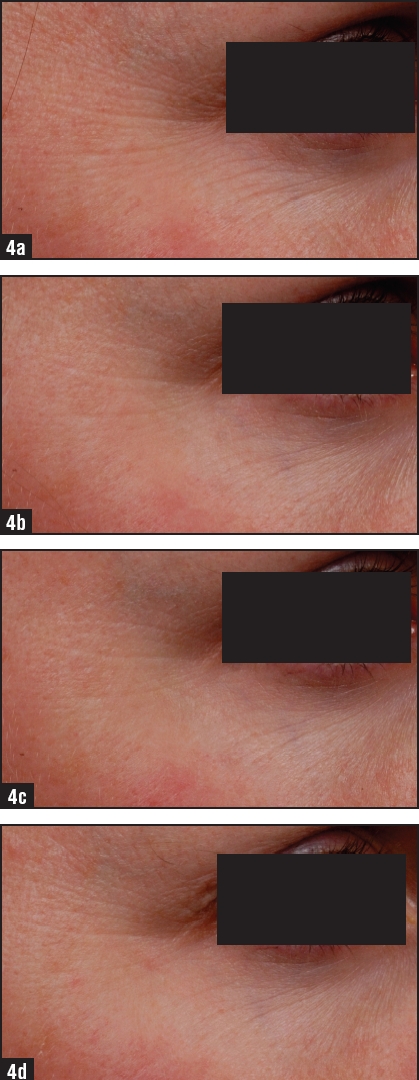Abstract
Objective: To evaluate the efficacy and tolerance of a novel line treatment for periocular and perioral wrinkles. The line treatment was formulated with multiple growth factors, antioxidants, and a collagen-building peptide—ingredients that have been shown to increase collagen levels and provide long-term aesthetic benefits. To help provide immediate smoothing effects, hyaluronic acid filling spheres and a muscle contraction-inhibiting peptide were also included in the formulation. Design: Three-month, single-center, open-label, clinical study with clinical assessments at Baseline, Minutes (within 15 minutes of initial application), Month 1, and Month 3. Treatment: Subjects treated periocular and perioral wrinkles twice daily for three months with the line treatment. Participants: Thirty-seven females, 33 to 45 years of age, with mild-to-moderate, fine and coarse periocular and perioral wrinkles, were enrolled in the study. Measurements: Investigator assessments of fine and coarse periocular and perioral wrinkles, digital photography, and tolerance assessments were conducted at all visits. Subject self-assessment questionnaires were conducted within 15 minutes of initial application and at Month 3. Results: Investigator assessments of both periocular and perioral wrinkles showed statistically significant improvements over Baseline within minutes of initial application; these positive findings continued to improve through Months 1 and 3 (all P≤0.0003). No treatment-related adverse events were reported. Conclusions: The results from this study demonstrate that this uniquely formulated line treatment was well tolerated and provided both immediate and long-term improvements in the appearance of fine and coarse wrinkles.
One of the most prominent signs of skin aging is the development of fine lines and wrinkles caused by both intrinsic and environmentally induced aging processes.1 Intrinsic aging is a naturally occurring process relating to chronological age; whereas, environmentally induced aging results from external factors, the most notable of which is ultraviolet (UV) exposure. The main structural changes resulting from both types of aging are characterized by a reduction in collagen and elastin and a loss in hydration; all of which contribute to the appearance of lines and wrinkles. Reactive oxygen species (ROS), a byproduct of both environmentally induced and intrinsic aging, cause a cascade of biochemical reactions within the skin, which results in the production of matrix metalloproteinases (MMPs) and proinflammatory cytokines. MMPs, secreted by fibroblasts and keratinocytes, decrease collagen formation and enhance collagen degradation, contributing to the breakdown of the dermal matrix.2–4 Proinflammatory cytokines lead to the degradation of elastin and also cause the production of additional ROS.
In addition to these structural changes in collagen and elastin, facial areas associated with expression movement, such as the periocular and perioral areas, are especially vulnerable to wrinkle formation. As a result, it can be challenging for physicians and patients to find a topical treatment that produces visible improvement in these areas.
To address the challenge of treating expressive facial areas, a topical line treatment containing a combination of ingredients was formulated to provide immediate improvements in the visible signs of aging as well as long-term anti-aging benefits. Multiple growth factors, peptides, and antioxidants were incorporated into the formulation for their ability to increase collagen levels by targeting various biochemical processes involved in collagen production and degradation. In addition, to affect immediate physical improvements in wrinkle appearance, a muscle contraction-inhibiting peptide and dehydrated hyaluronic acid (HA) filling spheres were included in the formulation. The hygroscopic properties of HA and its ability to create and fill space have been well documented.5,6 The filling spheres, which penetrate into superficial folds of the skin, take advantage of HA’s properties and swell when hydrated, exerting pressure in the direction of the skin surface resulting in a smoothing effect on the skin. To soften the appearance of fine lines, light-diffusing ingredients, such as specialized polymeric microspheres, were also included in the line treatment.
In recent years, growth factors have emerged as novel anti-aging agents due to their active role in dermal wound repair.7 The significance of the wound-healing process relates to the similarities between the biochemical pathways involved in the aging process and wound formation.8 Both processes stimulate the release of growth factors, which affect a variety of biochemical pathways critical to repair of the dermal matrix. In addition, topical growth factors have been shown in clinical studies to decrease the appearance of wrinkles and to stimulate collagen synthesis.8–11
Peptides are another group of novel ingredients included in the line treatment that play an important role in collagen synthesis and degradation. These protein building blocks are used in the body to signal between cells and influence the up- and down-regulation of various cellular functions. One of the peptides included in the treatment, palmitoyl tripeptide-5, is a synthetic peptide that mimics the sequence found in the protein thrombospondin 1 (TSP-1). TSP-1 has been shown to activate latent tissue growth factor β (TGF-β), a growth factor involved in the stimulation of collagen production.12,13 To aid in the prevention of collagen degradation, the peptide dipalmitoyl hydroxyproline was incorporated for its ability to promote the production of tissue inhibitors of metalloproteinases (TIMPs), thereby suppressing the synthesis of MMPs.14
Another peptide, unrelated to collagen synthesis and degradation, was formulated into the line treatment to target neuromuscular activity. Dipeptide diaminobutyroyl benzylamide diacetate was developed to mimic Waglerin-1, a compound found in temple viper snake venom. Waglerin-1 has been shown to block the nicotinic acetylcholine receptors at the neuromuscular junction, thus inhibiting muscular movement.15 The function of the Wagerlin-1-mimicking peptide is important for the treatment of lines since facial areas associated with repeated muscle movement are especially susceptible to wrinkle formation.
Lastly, the potent antioxidants, ubiquinone and vitamins C and E were incorporated to prevent and reduce oxidative damage, thereby minimizing the effects caused by UV exposure and intrinsic aging.16–18
The purpose of this three-month, open-label, single-center study was to evaluate the efficacy and tolerance of this line treatment for periocular and perioral wrinkles.
Methods
Study population. The criteria for study participation included females 30 to 45 years of age with Fitzpatrick skin types I–III with mild-to-moderate fine and coarse periocular wrinkles (scores of 1–6.5) as determined by the clinical investigator. Although not a requirement for study participation, subjects who also had mild-to-moderate fine and coarse perioral wrinkles (scores of 1–6.5) were included in the study.
Subjects could not have used any facial products containing alpha- or beta-hydroxy acids, retinoids, benzoyl peroxide, and salicylic acid within 30 days of study start. In addition, subjects could not have had botulinum toxin, facial fillers, a facial chemical peel, or any other resurfacing procedure within six months of study start. Subjects were instructed not to use any of the above facial products nor begin use of any new facial products or procedures during the study.
Study design. During the three-month, open-label study, eligible subjects applied the product to their periocular and perioral wrinkles twice daily for three months. Investigator assessments of fine and coarse periocular and perioral wrinkles and tolerance assessments were conducted at all visits including Baseline, Minutes (within 15 minutes of initial application), Month 1, and Month 3. Digital photographs of the left and right sides of the face were also taken at all visits.
Study endpoints. Efficacy. Investigator evaluations of fine and coarse wrinkles in the periocular and perioral areas were assessed at Baseline, Minutes, Month 1, and Month 3. For the periocular assessments, the left and right sides were graded separately. The wrinkles were graded using a 10-point scale with half-point scores allowed, where 0 = none, 0.5 to 3.5 = mild, 4 to 6.5 = moderate, and 7 to 9 = severe.
Safety. Tolerance was assessed at all visits by objective and subjective irritation parameters and the reporting of adverse events. The investigator assessed objective irritation, including overall erythema, edema, and scaling. For subjective irritation, subjects rated overall burning/stinging, itching, and tingling. Both objective and subjective irritation parameters were assessed on a four-point scale where 0 = none, 1 = mild, 2 = moderate, and 3 = severe. Half-point scores were allowed.
Subject self assessment. Subjects completed a self-assessment questionnaire asking them to rate their experience using the line treatment within minutes of initial application and at Month 3.
Statistical analysis. All scores at each visit were statistically compared to Baseline scores using a paired t test. Changes from baseline were considered significant at the P<0.05 level. Mean percent change from baseline and incidence of positive responders were reported for the Subject Self-Assessment Questionnaire.
Results
Demographics. Of the 37 female subjects that were enrolled, 35 completed the three-month study. The majority of subjects were Caucasian (92%) and the remaining were Hispanic and Native American (8%). Subjects were 33 to 45 years of age with mild or moderate, fine and coarse periocular and perioral wrinkles. Mean baseline fine and coarse periocular scores were 3.55 and 2.03, respectively; mean baseline fine and coarse perioral scores were 2.25 and 1.36, respectively.
Efficacy. Statistically significant reductions in mean scores for fine and coarse periocular wrinkles were achieved within minutes of initial product application with continued improvements observed through Months 1 and 3 (all P<0.0001). The mean percent changes in wrinkle severity at all visits compared to Baseline are presented in Figure 1, with negative values indicating improvements. In addition, fine and coarse perioral wrinkles also showed significant improvements at all visits (all P≤0.0003) (Figure 2). Visible improvements in periocular wrinkles are displayed in Figures 3 and 4.
Figure 1.

Mean reductions from baseline in periocular wrinkles
Figure 2.

Mean reductions from baseline in perioral wrinkles
Figures 3a–3d.

Thirty-four-year-old female periocular area at Baseline, Minutes, Month 1, and Month 3
Figures 4a–4d.

Thirty-four-year-old female periocular area at Baseline, Minutes, Month 1, and Month 3
Within minutes of initial application, subjects noticed benefits from using the line treatment, as demonstrated by the percentage of subjects selecting “agree strongly” or “agree” in response to the questionnaire. Most notably, subjects felt the line treatment made their skin feel firmer and tightened, look smoother, feel refreshed and more youthful, and brightened the area around their eyes (all P<0.05). After three months of use, subjects reported additional improvements in the appearance of their facial wrinkles. Subject responses to the questionnaire within minutes of initial application and at Month 3 are presented in Table 1. Overall the line treatment was highly rated by subjects with 83 percent rating their overall satisfaction at Month 3 as “excellent” or “good.”
Table 1.
Subject self-assessment questionnaire: Minutes and Month 3 Percent of subjects (agree strongly or agree)
| MINUTES (N=37) | MONTH 3 (N=35) | |
|---|---|---|
| Softened the fine lines/wrinkles around my eyes | 65% | 86% |
| Made my skin look smoother | 68% | 83% |
| Brightened the area around my eyes | 62% | 80% |
| Made my skin feel refreshed | 81% | 80% |
| Made my skin feel firmer and tightened | 86% | 80% |
| Softened the fine lines/wrinkles around my upper lip | 58% | 71% |
| Is convenient to use as part of my daily skin care regimen | Not asked | 86% |
| Is comfortable to use under my makeup | Not asked | 88% |
| Is easy to use | Not asked | 86% |
Safety. The line treatment was well tolerated as demonstrated by low mean scores (<0.05) for edema, scaling, burning/stinging, itching, and tingling tolerance parameters. Mean scores for erythema decreased at Month 3 from Baseline (0.78 to 0.57, respectively). Mean scores for all objective and subjective tolerance parameters are presented in Table 2. No treatment-related adverse events were reported.
Table 2.
Mean objective and subjective tolerance scores
| BASELINE | MINUTES | MONTH 1 | MONTH 3 | |
|---|---|---|---|---|
| Erythema | 0.78 | 0.77 | 0.76 | 0.57 |
| Edema | 0.00 | 0.00 | 0.00 | 0.00 |
| Scaling | 0.00 | 0.00 | 0.00 | 0.00 |
| Burning/stinging | 0.00 | 0.01 | 0.03 | 0.00 |
| Itching | 0.00 | 0.03 | 0.00 | 0.00 |
| Tingling | 0.00 | 0.05 | 0.00 | 0.00 |
Discussion
In this clinical study, the topical line treatment demonstrated both immediate and long-term improvements in the appearance of mild and moderate, fine and coarse periocular and perioral wrinkles, as confirmed by both clinical and subject assessments. These results are of particular note since the wrinkles in these facial regions tend to pose a treatment challenge for patients and physicians alike.
The early onset of efficacy observed within minutes of application suggests that this unique combination of HA filling spheres and a muscle contraction-inhibiting peptide may work synergistically to promote rapid reductions in wrinkle appearance. The ability of HA to attract and retain moisture may contribute to the observed smoothing effect on lines and wrinkles. The HA in the spheres acts like a molecular sponge, causing the filling spheres to swell and exert pressure in the direction of the surface, resulting in a smoothing effect on the skin. The immediate improvement in wrinkle appearance may also be due to the muscle-relaxing effects of the Waglerin-1 mimicking peptide as wrinkles in the periocular and perioral areas are often associated with repeated muscle movement. In addition, the light-diffusing polymeric microspheres in the line treatment may also soften the appearance of fine lines in these facial areas.
The line treatment demonstrated continued improvement in both fine and coarse wrinkles over the course of the study. Results observed at Months 1 and 3 may be attributed to the long-term effects of the growth factors and peptides. These ingredients have been shown to prevent MMP-induced damage to the dermal matrix by targeting various biochemical processes involved in collagen production and degradation.8–10,12–14 In addition, the antioxidants in the line treatment may provide protection from UV-induced ROS, preventing the cascade of reactions that would ultimately lead to the structural changes associated with intrinsic and environmentally induced aging.16–18
Frequently, invasive or surgical procedures, such as injections and lasers, are chosen for the immediate and significant improvements they produce in facial wrinkles.
However, these procedures are also associated with certain disadvantages, such as a potential risk for complications and a period of recovery time.19,20 The line treatment produced significant improvements in facial wrinkles and provides a well-tolerated, no-downtime alternative to invasive procedures.
References
- 1.Uitto J. The role of elastin and collagen in cutaneous aging: intrinsic aging versus photoexposure. J Drugs Dermatol. 2008;7(2):S12–16. [PubMed] [Google Scholar]
- 2.Fisher GJ, Wang ZQ, Datta SC, et al. Pathophysiology of premature skin aging induced by ultraviolet light. N Engl J Med. 1997;337:1419–1428. doi: 10.1056/NEJM199711133372003. [DOI] [PubMed] [Google Scholar]
- 3.Varani J, Fisher GJ, Kang S, Voorhees JJ. Molecular mechanisms of intrinsic skin aging and retinoid-induced repair and reversal. J Invest Dermatol Symp Proc. 1998;3:57–60. [PubMed] [Google Scholar]
- 4.Brenneisen P, Wenk J, Klotz LO, et al. Central role of ferrous/ferric iron in the ultraviolet B irradiation mediated signaling pathway leading to increased interstitial collagenase (matrix-degrading metalloprotease (MMP)-1) and stromelysin-1 (MMP-3) mRNA levels in cultured human dermal fibroblasts. J Biol Chem. 1998;273:5279–5287. doi: 10.1074/jbc.273.9.5279. [DOI] [PubMed] [Google Scholar]
- 5.Galus R, Antiszko M, Wlodarski P. Clinical applications of hyaluronic acid. Pol Merkur Lekarski. 2006;20(119):606–608. [PubMed] [Google Scholar]
- 6.Weindl G, Schaller M, Schäfer-Korting M, Korting HC. Hyaluronic acid in the treatment and prevention of skin diseases: molecular biological, pharmaceutical and clinical aspects. Skin Pharmacol Physiol. 2004;17(5):207–213. doi: 10.1159/000080213. [DOI] [PubMed] [Google Scholar]
- 7.Mehta RC, Smith Sr, Grove GL, et al. Reduction in facial photodamage by a topical growth factor product. J Drugs Dermatol. 2008;7(9):864–871. [PubMed] [Google Scholar]
- 8.Mehta RC, Fitzpatrick RE. Endogenous growth factors as cosmeceuticals. Dermatol Ther. 2007;20(5):350–359. doi: 10.1111/j.1529-8019.2007.00149.x. [DOI] [PubMed] [Google Scholar]
- 9.Fitzpatrick RE, Rostan EF. Reversal of photodamage with topical growth factors: a pilot study. J Cosmet Laser Ther. 2003;5:25–34. doi: 10.1080/14764170310000817. [DOI] [PubMed] [Google Scholar]
- 10.Ehrlich M, Rao J, Pabby A, Goldman MP. Improvement in the appearance of wrinkles with topical transforming growth factor beta(1) and 1-ascorbic acid. Dermatol Surg. 2006;32:618–625. doi: 10.1111/j.1524-4725.2006.32132.x. [DOI] [PubMed] [Google Scholar]
- 11.Gold MH, Goldman MP, Biron J. Efficacy of novel skin cream containing mixture of human growth factors and cytokines for skin rejuvenation. J Drugs Dermatol. 2007;6:197–201. [PubMed] [Google Scholar]
- 12.Murphy-Ullrich JE, Poczatek M. Activation of latent TGF-β by thrombospondin-1: mechanisms and physiology. Cytokine Growth Factor Rev. 2000;11:59–69. doi: 10.1016/s1359-6101(99)00029-5. [DOI] [PubMed] [Google Scholar]
- 13.Varga J., Rosenbloom J, Jimenez SA. Transforming growth factor β (TGF-β) causes a persistent increase in steadystate amounts of type I and type III collagen and fibronectin mRNAs in normal human dermal fibroblasts. Biochem J. 1987;247:597–604. doi: 10.1042/bj2470597. [DOI] [PMC free article] [PubMed] [Google Scholar]
- 14.Bode W, Fernandez-Catalan C, Grams F, et al. Insights into MMP-TIMP Interactions. Ann N Y Acad Sci. 1999;878:73–91. doi: 10.1111/j.1749-6632.1999.tb07675.x. [DOI] [PubMed] [Google Scholar]
- 15.McArdle JJ, Lentz TL, Witzemann V, et al. Wagerlin-1 selectively blocks the epsilon form of the muscle nicotinic acetylcholine receptor. J Pharmacol Exp Ther. 1999;289:543–550. [PubMed] [Google Scholar]
- 16.Burke KE. Interaction of vitamins C and E as better cosmeceuticals. Dermatol Ther. 2007;20(5):314–321. doi: 10.1111/j.1529-8019.2007.00145.x. [DOI] [PubMed] [Google Scholar]
- 17.Farris PK. Topical vitamin C: a useful agent for treating photoaging and other dermatologic conditions. Dermatol Surg. 2005;31:814–817. doi: 10.1111/j.1524-4725.2005.31725. [DOI] [PubMed] [Google Scholar]
- 18.Hoppe U, Bergemann J, Diembeck W, et al. Coenzyme Q10, a cutaneous antioxidant and energizer. Biofactors. 1999;9(2-4):371–378. doi: 10.1002/biof.5520090238. [DOI] [PubMed] [Google Scholar]
- 19.Lemperle G, Gauthier-Hazan N, Wolters M. Complications after dermal fillers and their treatment. Handchir Mikrochir Plast Chir. 2006;38(6):354–369. doi: 10.1055/s-2006-955889. [DOI] [PubMed] [Google Scholar]
- 20.Tanzi EL, Alster TS. Single-pass carbon dioxide versus multiple-pass Er:YAG laser skin resurfacing: a comparison of postoperative wound healing and side-effect rates. Dermatol Surg. 2003;29(1):80–84. doi: 10.1046/j.1524-4725.2003.29012.x. [DOI] [PubMed] [Google Scholar]


